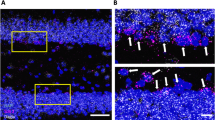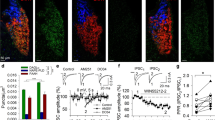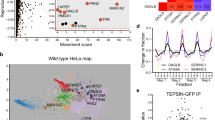Abstract
Psychosocial stress is a risk factor for development and exacerbation of neuropsychiatric illness. Repeated stress causes biochemical adaptations in endocannabinoid (eCB) signaling that contribute to stress–response habituation, however, the synaptic correlates of these adaptations have not been examined. Here, we show that the synthetic enzyme for the eCB 2-arachidonoylglycerol (2-AG), diacylglycerol (DAG) lipase alpha, is heterogeneously expressed in the amygdala, and that levels of 2-AG and precursor DAGs are increased in the basolateral amygdala (BLA) after 10 days, but not 1 day, of restraint stress. In contrast, arachidonic acid was decreased after both 1 and 10 days of restraint stress. To examine the synaptic correlates of these alterations in 2-AG metabolism, we used whole-cell electrophysiology to determine the effects of restraint stress on depolarization-induced suppression of inhibition (DSI) in the BLA. A single restraint stress exposure did not alter DSI compared with control mice. However, after 10 days of restraint stress, DSI duration, but not magnitude, was significantly prolonged. Inhibition of 2-AG degradation with MAFP also prolonged DSI duration; the effects of repeated restraint stress and MAFP were mutually occlusive. These data indicate that exposure to repeated, but not acute, stress produces neuroadaptations that confer BLA neurons with an enhanced capacity to elevate 2-AG content and engage in 2-AG-mediated short-term retrograde synaptic signaling. We suggest stress-induced enhancement of eCB-mediated suppression of inhibitory transmission in the BLA could contribute to affective dysregulation associated with chronic stress.
Similar content being viewed by others
Log in or create a free account to read this content
Gain free access to this article, as well as selected content from this journal and more on nature.com
or
References
Ahn K, McKinney MK, Cravatt BF (2008). Enzymatic pathways that regulate endocannabinoid signaling in the nervous system. Chem Rev 108: 1687–1707.
Azad SC, Eder M, Marsicano G, Lutz B, Zieglgansberger W, Rammes G (2003). Activation of the cannabinoid receptor type 1 decreases glutamatergic and GABAergic synaptic transmission in the lateral amygdala of the mouse. Learn Mem 10: 116–128.
Azad SC, Monory K, Marsicano G, Cravatt BF, Lutz B, Zieglgansberger W et al (2004). Circuitry for associative plasticity in the amygdala involves endocannabinoid signaling. J Neurosci 24: 9953–9961.
Blankman JL, Simon GM, Cravatt BF (2007). A comprehensive profile of brain enzymes that hydrolyze the endocannabinoid 2-arachidonoylglycerol. Chem Biol 14: 1347–1356.
Carter E, Wang XJ (2007). Cannabinoid-mediated disinhibition and working memory: dynamical interplay of multiple feedback mechanisms in a continuous attractor model of prefrontal cortex. Cereb Cortex 17 (Suppl 1): i16–i26.
Caspi A, Sugden K, Moffitt TE, Taylor A, Craig IW, Harrington H et al (2003). Influence of life stress on depression: moderation by a polymorphism in the 5-HTT gene. Science 301: 386–389.
Edwards DA, Zhang L, Alger BE (2008). Metaplastic control of the endocannabinoid system at inhibitory synapses in hippocampus. Proc Natl Acad Sci USA 105: 8142–8147.
Hammen C (2005). Stress and depression. Annu Rev Clin Psychol 1: 293–319.
Hammen C, Brennan PA, Shih JH (2004). Family discord and stress predictors of depression and other disorders in adolescent children of depressed and nondepressed women. J Am Acad Child Adolesc Psychiatry 43: 994–1002.
Hashimotodani Y, Ohno-Shosaku T, Kano M (2007a). Ca(2+)-assisted receptor-driven endocannabinoid release: mechanisms that associate presynaptic and postsynaptic activities. Curr Opin Neurobiol 17: 360–365.
Hashimotodani Y, Ohno-Shosaku T, Kano M (2007b). Presynaptic monoacylglycerol lipase activity determines basal endocannabinoid tone and terminates retrograde endocannabinoid signaling in the hippocampus. J Neurosci 27: 1211–1219.
Hill MN, Gorzalka BB (2005). Is there a role for the endocannabinoid system in the etiology and treatment of melancholic depression? Behav Pharmacol 16: 333–352.
Juhasz G, Chase D, Pegg E, Downey D, Toth ZG, Stones K et al (2009). CNR1 gene is associated with high neuroticism and low agreeableness and interacts with recent negative life events to predict current depressive symptoms. Neuropsychopharmacology 34: 2019–2027.
Jung KM, Astarita G, Zhu C, Wallace M, Mackie K, Piomelli D (2007). A key role for diacylglycerol lipase-alpha in metabotropic glutamate receptor-dependent endocannabinoid mobilization. Mol Pharmacol 72: 612–621.
Jung KM, Mangieri R, Stapleton C, Kim J, Fegley D, Wallace M et al (2005). Stimulation of endocannabinoid formation in brain slice cultures through activation of group I metabotropic glutamate receptors. Mol Pharmacol 68: 1196–1202.
Kamprath K, Marsicano G, Tang J, Monory K, Bisogno T, Di Marzo V et al (2006). Cannabinoid CB1 receptor mediates fear extinction via habituation-like processes. J Neurosci 26: 6677–6686.
Kano M, Ohno-Shosaku T, Hashimotodani Y, Uchigashima M, Watanabe M (2009). Endocannabinoid-mediated control of synaptic transmission. Physiol Rev 89: 309–380.
Katona I, Rancz EA, Acsady L, Ledent C, Mackie K, Hajos N et al (2001). Distribution of CB1 cannabinoid receptors in the amygdala and their role in the control of GABAergic transmission. J Neurosci 21: 9506–9518.
Katona I, Urban GM, Wallace M, Ledent C, Jung KM, Piomelli D et al (2006). Molecular composition of the endocannabinoid system at glutamatergic synapses. J Neurosci 26: 5628–5637.
Kreitzer AC, Regehr WG (2001). Cerebellar depolarization-induced suppression of inhibition is mediated by endogenous cannabinoids. J Neurosci 21: RC174.
Long JZ, Li W, Booker L, Burston JJ, Kinsey SG, Schlosburg JE et al (2009). Selective blockade of 2-arachidonoylglycerol hydrolysis produces cannabinoid behavioral effects. Nat Chem Biol 5: 37–44.
Marsicano G, Wotjak CT, Azad SC, Bisogno T, Rammes G, Cascio MG et al (2002). The endogenous cannabinoid system controls extinction of aversive memories. Nature 418: 530–534.
Mato S, Chevaleyre V, Robbe D, Pazos A, Castillo PE, Manzoni OJ (2004). A single in-vivo exposure to delta 9THC blocks endocannabinoid-mediated synaptic plasticity. Nat Neurosci 7: 585–586.
Melchior M, Caspi A, Milne BJ, Danese A, Poulton R, Moffitt TE (2007). Work stress precipitates depression and anxiety in young, working women and men. Psychol Med 37: 1119–1129.
Moreira FA, Lutz B (2008). The endocannabinoid system: emotion, learning and addiction. Addict Biol 13: 196–212.
Nomura DK, Hudak CS, Ward AM, Burston JJ, Issa RS, Fisher KJ et al (2008). Monoacylglycerol lipase regulates 2-arachidonoylglycerol action and arachidonic acid levels. Bioorg Med Chem Lett 18: 5875–5878.
Patel S, Cravatt BF, Hillard CJ (2005a). Synergistic interactions between cannabinoids and environmental stress in the activation of the central amygdala. Neuropsychopharmacology 30: 497–507.
Patel S, Hillard CJ (2003). Cannabinoid-induced Fos expression within A10 dopaminergic neurons. Brain Res 963: 15–25.
Patel S, Hillard CJ (2008). Adaptations in endocannabinoid signaling in response to repeated homotypic stress: a novel mechanism for stress habituation. Eur J Neurosci 27: 2821–2829.
Patel S, Roelke CT, Rademacher DJ, Hillard CJ (2005b). Inhibition of restraint stress-induced neural and behavioural activation by endogenous cannabinoid signalling. Eur J Neurosci 21: 1057–1069.
Piomelli D (2003). The molecular logic of endocannabinoid signalling. Nat Rev 4: 873–884.
Pittenger C, Duman RS (2008). Stress, depression, and neuroplasticity: a convergence of mechanisms. Neuropsychopharmacology 33: 88–109.
Quirk GJ, Gehlert DR (2003). Inhibition of the amygdala: key to pathological states? Ann N Y Acad Sci 985: 263–272.
Rademacher DJ, Meier SE, Shi L, Ho WS, Jarrahian A, Hillard CJ (2008). Effects of acute and repeated restraint stress on endocannabinoid content in the amygdala, ventral striatum, and medial prefrontal cortex in mice. Neuropharmacology 54: 108–116.
Rossi S, De Chiara V, Musella A, Kusayanagi H, Mataluni G, Bernardi G et al (2008). Chronic psychoemotional stress impairs cannabinoid-receptor-mediated control of GABA transmission in the striatum. J Neurosci 28: 7284–7292.
Sah P, Faber ES, Lopez De Armentia M, Power J (2003). The amygdaloid complex: anatomy and physiology. Physiol Rev 83: 803–834.
Uchigashima M, Narushima M, Fukaya M, Katona I, Kano M, Watanabe M (2007). Subcellular arrangement of molecules for 2-arachidonoyl-glycerol-mediated retrograde signaling and its physiological contribution to synaptic modulation in the striatum. J Neurosci 27: 3663–3676.
Viveros MP, Marco EM, File SE (2005). Endocannabinoid system and stress and anxiety responses. Pharmacol Biochem Behav 81: 331–342.
Wilson RI, Nicoll RA (2001). Endogenous cannabinoids mediate retrograde signalling at hippocampal synapses. Nature 410: 588–592.
Yamagata K, Andreasson KI, Kaufmann WE, Barnes CA, Worley PF (1993). Expression of a mitogen-inducible cyclooxygenase in brain neurons: regulation by synaptic activity and glucocorticoids. Neuron 11: 371–386.
Zhu PJ, Lovinger DM (2005). Retrograde endocannabinoid signaling in a postsynaptic neuron/synaptic bouton preparation from basolateral amygdala. J Neurosci 25: 6199–6207.
Acknowledgements
These studies were supported by the National Institutes of Health Grants DA19112, AA15635, DA11322, DA21696, and GM15431. SP was supported by the Vanderbilt University Department of Psychiatry, and a grant from the Vanderbilt Institute for Clinical and Translational Research.
Author information
Authors and Affiliations
Corresponding author
Additional information
DISCLOSURE
The authors declare no conflict of interest.
Rights and permissions
About this article
Cite this article
Patel, S., Kingsley, P., Mackie, K. et al. Repeated Homotypic Stress Elevates 2-Arachidonoylglycerol Levels and Enhances Short-Term Endocannabinoid Signaling at Inhibitory Synapses in Basolateral Amygdala. Neuropsychopharmacol 34, 2699–2709 (2009). https://doi.org/10.1038/npp.2009.101
Received:
Revised:
Accepted:
Published:
Issue date:
DOI: https://doi.org/10.1038/npp.2009.101
Keywords
This article is cited by
-
Pharmacological diacylglycerol lipase inhibition impairs contextual fear extinction in mice
Psychopharmacology (2024)
-
Endocannabinoids at the synapse and beyond: implications for neuropsychiatric disease pathophysiology and treatment
Neuropsychopharmacology (2023)
-
Insular cortex corticotropin-releasing factor integrates stress signaling with social affective behavior
Neuropsychopharmacology (2022)
-
Delineation of an insula-BNST circuit engaged by struggling behavior that regulates avoidance in mice
Nature Communications (2021)
-
Long-Term Aberrations To Cerebellar Endocannabinoids Induced By Early-Life Stress
Scientific Reports (2020)



